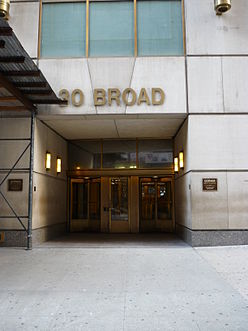- Continental Bank Building
-
Continental Bank Building
Continental Bank Building at 30 Broad StreetGeneral information Type Banking, Brokering Address 30 Broad Street Town or city New York, New York Country United States Current tenants Continental Bank Opening 27 August 1932 Cost $20 million Height 564 feet (172 m) Technical details Floor count 48 Floor area 300,000 square feet (28,000 m2) Design and construction Architect Morris, O’Connor Architecture firm Cross and Cross The Continental Bank Building is a skyscraper in New York City that was completed in 1932.
Origins
In 1929, a new 50-story building was announced at 30 Broad Street (location of the 15-story Johnston Building) to house the Continental Bank and various brokers. The site extends along Broad Street at 87 feet 7 inches (26.70 m), the length of Exchange Place runs 149 feet 8.5 inches (45.631 m) from New Street, and runs 88 feet (27 m) along New Street. The building site was once owned by the Dutch church which had erected the city’s second almshouse on the site before 1659. Broad Street was originally a canal first known as “Common Ditch” then later “The Prince’s Ditch”.
The canal was filled in 1676, and it was first paved in 1693. The estimated cost of the new building is $20 million. The project is the largest single cooperative building venture undertaken to this time. Cross and Cross architects are announced as the building’s planners. An “unusual” feature of the building is a sub-basement clearing house where owner-tenants each have floor space and can transact business with other owner-tenants in the building by a system of pneumatic tubes to exchange receipts.
Design and construction
Architects Morris and O’Connor completed drawings in 1931 indicating 48 stories, 564 feet (172 m) above street level with a “simple” architecture. According to the architects, the structure is designed to express straightforward business of the highest class without excessive ornamentation. The first three stories of the façade are clad in limestone with the remainder made up of light-colored brick and dark brick at the spandrels. The building footprint rises from street level to floor 20 where the first setback is made until floor 23 where another setback is located.
The building tower then rises from floor 24 to floor 48. The top of the building is flat (having no ornament). The building’s lobby runs through from Broad Street to New Street with two elevator banks which serve the building, one set from the lobby to floor 20 and the other from the lobby to floors 21 through 47. The 48th floor is accessed by stairs from floor 47. Total rentable space is announced as 300,000 square feet (28,000 m2).
Structural facts
The building columns sit on new footings which rest upon rocks. The average depth of the new foundations is 46 feet (14 m) below Broad Street. However, the Broad Street side of the building rests on existing caissons. An adjoining structure along the southern property line required triple cantilever plate girders to provide headroom for the elevator doors. There are three floors below ground. The total building weight is estimated at 55,000 tons (7,000 tons of steel).
The demolition of the Johnston building was spanned from May 5 to July 13. The 15-story structure had exterior masonry that beared walls composed of granite (some pieces weighing as much as 10 tons) that were up to three feet thick at the lower walls. The exterior was ashlar granite while the interior was common brick backup laid in cement mortar. The steel structure was only designed to carry the floor loads, because the exterior was self-supporting.
The building opened for occupancy on April 27, 1932.
Categories:- Buildings and structures in Manhattan
Wikimedia Foundation. 2010.

